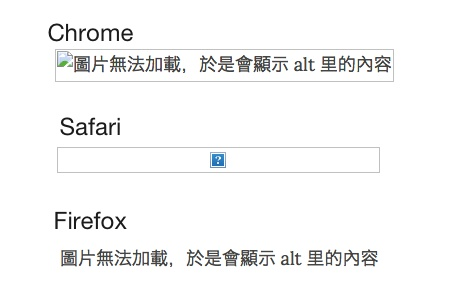「前端的基礎修養」是我擬寫的一系列文章的總標題。所以喚作「修養」,大抵因為心虛,覺得沒有什麼技術含量,不便言之技術。這一系列會以亂序呈現,同一主題的文章會穿插出現。
這一篇談 Accessibility 相關的主題——aria-label 的使用。Accessibility 作為一個整體,是一個龐大而複雜的主題。這裡單講 aria-label,因其比較簡單與實用,作為切入點正合適。
可能有人不理解什麼是 Accessibility,這裡簡單解釋一下。比如地鐵有大通道方便輪椅通過,比如紅綠燈有聲音提示方便盲人通行,比如鼠標有左手模式方便習慣用左手的人使用。讓更廣泛(生理上有所不同)的人群可以使用,就是 Accessibility。
這個話題去歲在台灣談過,是參加 JSDC 2014 時講的,不被重視的 HTML:Accessibility。
aria-label 初窺
aria-label 是一個 HTML attribute,用來告訴讀屏軟件某個元素是什麼。例如一個關閉按鈕「×」,視覺上看來都能理解,但是讀屏軟件並不能正確讀出,這時就可以用 aria-label 告訴它:
<button aria-label="關閉">×</button>
讀屏軟件(比如說 Voice Over)就會讀出「按鈕,關閉」。圖片 <img> 的 alt 屬性亦有此效果,因為圖片本身是沒有辦法被讀出的,所以讀屏軟件會去閱讀 alt 的內容。
假如 <img> 標籤同時有 aria-label 與 alt 屬性,那麼讀屏軟件應該閱讀哪個的內容呢?答案當然是 aria-label。這裡需要明白 alt 本身還有另一個作用,當圖片無法加載時,瀏覽器會將 alt 的內容展示給用戶。

aria-label 與 title
全局屬性 title 是用作提示與補充的,你認為讀屏軟件會識別 title 麼?完全不會,Voice Over1、JAWS2、NVDA3 都不會去識別,title 對於 Accessibility 毫無幫助。
<a href="#" title="設置"><img src="gear.png"></a>
這段代碼是一個鏈接,使用一個圖片表示「設置」,使用 title 注釋。如果鼠標懸浮在鏈接上的話,會出現提示,但是讀屏軟件根本無法識別。你應該使用 aria-label 來代替 title:
<a href="#" aria-label="設置"><img src="gear.png"></a>
aria-label 與 iconfont
多數網站已經不使用圖片來表示 icon 了,轉而使用 iconfont 又或者 svg。無論是哪種方案,圖標都只是給視覺正常的人使用的。這個時候你需要使用 aria-label 來標注:
<a href="#"><i class="icon-gear" aria-label="設置"></i></a>
<a href="#" aria-label="設置"><i class="icon-gear"></i></a>
上面的例子里給出了兩種方案,一是在圖標本身的標籤上,一是在鏈接 <a> 上,兩種方案讀屏軟件都能正確識別,但是個人以為放在鏈接 <a> 上比較好,比如鏈接里是圖標加文字說明的形式:
<a href="#" aria-label="設置"><i class="icon-gear"></i> 設置</a>
這時便不能在 iconfont 上添加 aria-label 了,否則會念兩遍「設置」,但是這種情況更好的方法是使用 aria-hidden:
<a href="#"><i class="icon-gear" aria-hidden="true"></i> 設置</a>
aria-label 作為提示
但是許多時候,即使你能看清楚圖標,你也完全不知道那是個什麼鬼東西,圖標始終是一個抽象概念,並非人人都能理解。我們常會用 tooltip 作為提示,比如 jquery.tipsy。
jquery.tipsy 這個插件默認使用 title 作為數據來源,也可以使用其它屬性:
$('#example-custom-attribute').tipsy({title: 'aria-label'});
GitHub 使用的純 CSS 方案不錯,使用 CSS attr() 獲取 aria-label 的內容作為提示,在不需要兼容老舊瀏覽器的情況下建議使用,整理代碼如下:
.tip {
position: relative;
}
.tip:before {
display: none;
position: absolute;
top: auto;
right: 50%;
bottom: -7px;
margin-right: -5px;
width: 0;
height: 0;
content: '';
border: 5px solid transparent;
border-bottom-color: rgba(0, 0, 0, 0.9);
pointer-events: none;
z-index: 10000;
}
.tip:after {
display: none;
position: absolute;
top: 100%;
right: 50%;
padding: 0 10px;
border-radius: 3px;
background-color: rgba(0, 0, 0, 0.9);
color: #fff;
font-size: 11px;
font-weight: 500;
content: attr(aria-label);
white-space: pre;
z-index: 10000;
margin-top: 5px;
line-height: 26px;
transform: translateX(50%);
}

aria-label 與表單
placeholder 的出現導致了大量不帶 <label> 的 form 表單,然而讀屏軟件是不會識別 placeholder 的。例如:
<input name="username" placeholder="用戶名">
<input name="email" placeholder="郵箱">
對於視覺正常的人來說沒有問題,但是在讀屏軟件看來它只是兩個輸入框,至於需要輸入什麼,它是不知道的。這個時候你需要用 aria-label 再次標注:
<input name="username" placeholder="用戶名" aria-label="用戶名">
<input name="email" placeholder="郵箱" aria-label="郵箱">
還有另外一種方案,使用 <label>,但是不顯示 <label>:
<label for="username" class="sr-only">用戶名</label>
<input id="username" name="username" placeholder="用戶名">
使用 CSS 來隱藏 .sr-only(screen reader only) 這個 class 的標籤,注意不能使用 display: none,否則讀屏軟件會忽略,只在視覺上將其隱藏即可。
索引
aria-label 理論上是作用於所有 tag 的,但是我實際測試下來,不支持 h(n) 例如 h1-h6。
- https://dev.opera.com/articles/ux-accessibility-aria-label/
- http://webaim.org/techniques/forms/advanced
- http://www.deque.com/blog/text-links-practices-screen-readers/
- http://www.w3.org/TR/2015/WD-aria-in-html-20150521/
Voice Over 是 Apple (Mac & iOS) 的讀屏軟件↩
JAWS 是一個讀屏軟件,適用於 Windows↩
NVDA 是一個開源讀屏軟件 http://www.nvaccess.org/↩
